The 300m 6159-7001 (and 7000) diver is Seikos first proper attempt at a “professional” dive watch. When I say the first there was of course the 300m 6215-7001 which was released a year earlier in 1967, and the 150m 6217-8001 released in 1965, but according to the Seiko parts catalogue of the time these two models are listed as a divers watches and the 6159-7001 is listed as a professional divers watch – so who am I to argue with Seiko? Of course another clue is the fact the 6159 has”Professional” printed on the dial and the 6215 doesn’t! The 6215 and 6159 cases are very similar, both are monocoque and both share the same dimensions but the 6215 has a larger diameter crystal and slightly different bezel. It’s inside where the biggest changes are, instead of the 6215’s 35 jewel 19,800bph movement it has the beautiful 6159a movement, the 25 jewel, 36,000bph masterpiece that allows the seconds hand to almost glide around the dial. The case style and distinctive lines continue to this day in Seiko’s SBDX001 more commonly known as the MM300.
The example featured arrived looking rather sorry for itself.
The lume compound on the hands and dial was starting to rot and was just beginning to affect the gilt of the hands and indicies frames. The bezel had a very poor insert and had a tremendous ding in it at the 8 minute mark, also the movement was in need of a service. The first job was to remove the bezel and strip the case.
This being a monocoque case means the movement has to be removed through the front so the crystal locking ring has to be undone and a host of gaskets and nylon o-rings are removed to allow the stem button to be reached.
Once the button is depressed and the stem removed the movement can be taken out.
The movement looks to be in reasonable shape with little corrosion evident so a service should sort out any problems.
The dial and hands are in need of a sympathetic relume.
The movement was stripped ready for a trip through the cleaning machine and subsequent inspection.
At the time of refurbishing the watch we couldn’t source a genuine crystal so a bit of detective work was in order. The original crystal has the part number 325W14GN and we know this crystal can be used in the 7549-7010 tuna who’s part number is 325W16GA00. As these were also unavailable it turns out they were superseded by the crystal with a part number of 325W26HB0A so one of these was ordered and it fitted a treat. Common problems with substituting crystals on dive watches is that the inside curvature can be different which means the hands could foul the crystal, also the profile can be different, this time allowing the bezel to foul so it can be a bit of an expensive gamble if it does go wrong.
Another issue with these 6159 calbres is the barrel and mainspring can’t be opened, the barrel is flanged over the lid which prevents opening. The barrel is actually printed with “do not open” to warn you not to try! I have heard unsubstantiated rumours of the barrels being opened for cleaning but when it’s not your own watch the risk of something going wrong is too great, these parts have been unobtainable for years! I do have my own 6159-7001, and when I get around to servicing it I’m going to see if it is feasible to get it open without any damage.
The parts were loaded into the baskets and sent for a spin in the cleaning machine.
Once cleaned the parts were brought together for reassembly and the hands and dial were sent off to a specialist for a relume.
The motion work going back together.
With the autowind bridge and balance refitted ticking away nicely. These 6159a’s differ in a few subtle respects from the 6159b which was fitted to the 6159-7010 tuna.
As you can see in this comparison picture, the rotor is held by a single screw on the b and the curb pins on the regulator are adjustable.
Whilst the work was progressing with the movement I had an enormous stroke of luck regarding the bezel, I managed to source one that was in much better condition than the original.
The bezel retaining spring on the original was a “c” type, once these get worn they don’t hold the bezel on very well and this watch was no exception. I much prefer the 8 sided spring of the earlier 6217 divers, they hold the bezel in place much more firmly. As an 8 sided one was never made for this model I fabricated one from some stainless steel wire.
Meanwhile the hands and dial had returned from the relumers so they were fitted.
The watch was reassembled and the replacement bezel fitted, it’s now looking very smart.
The owner wanted this fully water resistant to the original specifications, as new seals had been fitted the first stage is a 6bar leak test which it passed successfully.
This allows it to go into the hydrostatic tester to be tested to its rated depth.
A drop in pressure is the indication all is not well, but even if everything is fine once the watch is out of the tester it’s warmed through on the warming plate then a cold droplet of water is placed on the crystal. If it fogs up below the droplet there has been moisture ingress.
Finally finished with all of it’s replaced parts.
It’s a beautiful high beat classic dive watch that’s now been brought fully back to health, these watches are one of my favourite Seikos of all time.



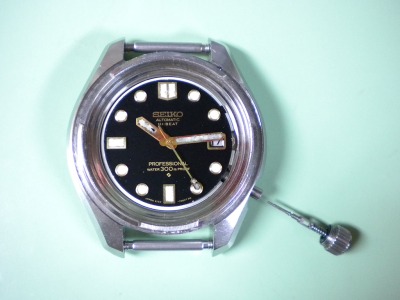



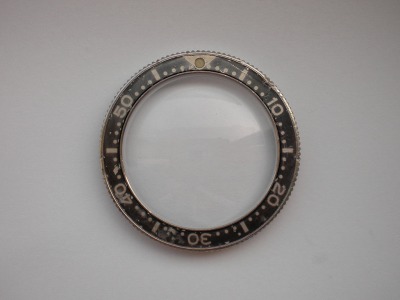



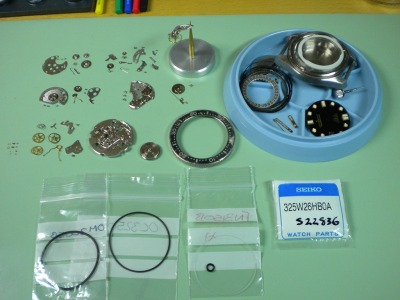


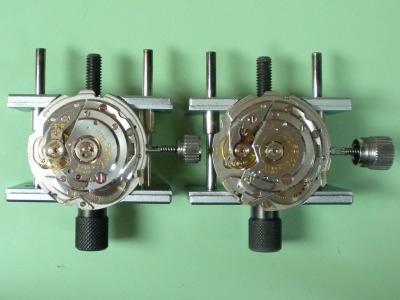
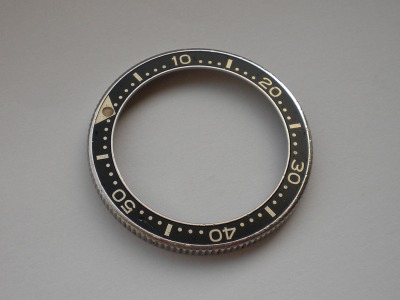

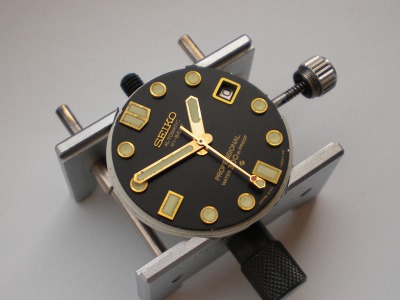



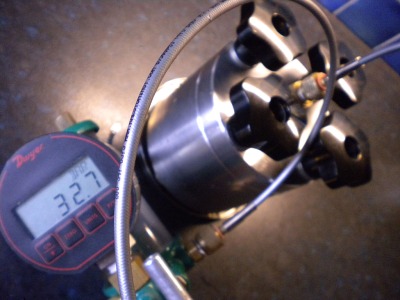





a fine write-up on a splendid piece of restoration. Congratulations.
LikeLike
Thank you, I was very pleased with how this iconic watch turned out.
LikeLike
A great restoration on such a classic piece, I have a question, how accurately can the hi-beat movements be regulated and is the 6159A a hacking movement? I perviously owned a MM300 which I sold as I have gone very much into the classic Seiko diver’s in the last 3 years, the 6159-7001 is a ‘grail’ for me.
LikeLike
If the movement is in good shape, for example no worn pivots, hairspring in good shape, the mainspring in good order and correctly lubricated, they can be adjusted to run very accurately. As I’m sure you know the 36,000bph helps with isochronicity and they are well designed and built movements. The 6159a is hand windable and hacks.
LikeLike
Great article. I have recently been given a 6159-7001 by my dad, who was given it as a present from his parents. It’s in great original condition and is working perfectly. There are a few scratches on the crystal and a small dent in the bezel. I am tossing up whether to have it overhauled/serviced or to leave it be.. Any advice would be appreciated!
I’m located in Sydney Australia so if anyone knows of a reputable company who service this kind of watch, please let me know 🙂
Cheers guys
Glenn.
LikeLike
I own a seiko 6159-7001 since 1969
Used it for many dives.
Still running perfectly.
LikeLike
Regarding the “do not open” barrels. A nice (sharpish with no jagged edges please) bench knife eased into the tiny groove where lid meets barrel and rotated around the barrel will have the lid off in a jiff. If they are of the inset type they can be pressed off with the arbor in the usual way but this may dome the lid which will need to be corrected later. I recently had one of these that was creased by a previous attempt. I replaced with a 6119 (if I recall correctly) barrel but you must use the stronger 6159 mainspring.
They are OK to leave as is if the greasing of the barrel wall is still functional. Once it has dried or been displaced it will load up the train wheels, escapement and the automatic work itself. Not good!
David George Watchmaker,
New Zealand.
LikeLike
But the only way you’ll know if the barrel wall grease is OK is to open it 🙂
To be honest the chances of the barrel wall grease being OK on a 1960’s watch that needs a service is pretty much zero. I prefer to relieve the crimp on the 61xx DNO barrels before taking the lid off, I’ve serviced one that had been creased (presumably when trying to remove it) and it sapped amplitude like you wouldn’t believe, just like you I had to substitute the barrel and lid to correct it.
LikeLike
Bought my Seiko 6159 7001 in 1970 used it years for diving, when stopped the watch lay forgotten at home. The original rubber bracelet was terrible as it tended to torn quickly had to replace this quite often just in case it went loose while diving. While trowing old stuff away i found the watch, did some checking on the internet and was amazed to read how valubale it is.
Had the watch serviced no new glass or polishing all still original, mounted black leather strap
and wear it now regular.
LikeLike
Looking to get a Vintage 6159-7001. Can you forward the person who restored your featured watch. Beautiful restoration work. Congratulations!
LikeLike
I’m genuinely lost for words!
LikeLiked by 1 person
Hi. I wonder if you can advise on or point me to a resource which can outline the difference between a Seiko 6159-7000 and a 6159-7001? I am the owner of the former, and am curios to learn more about its production distinctions versus the 7001. Any help you can provide much appreciated. Regards Barney Hylton
LikeLike